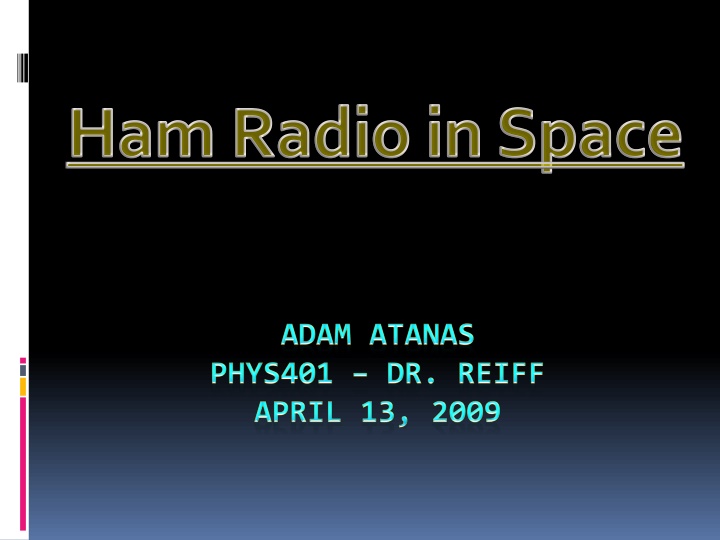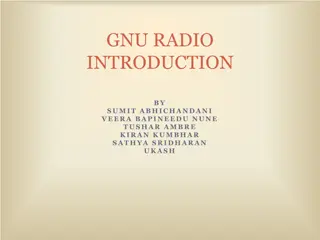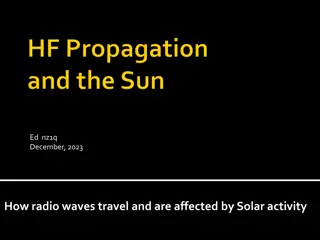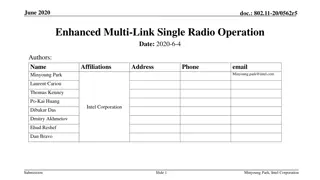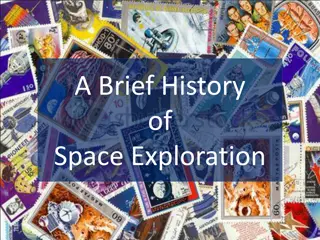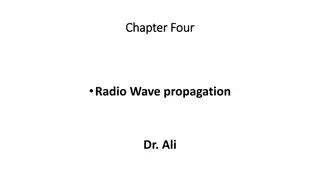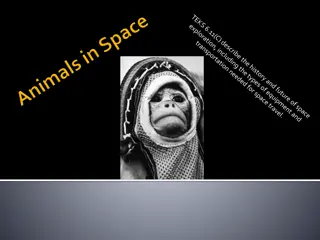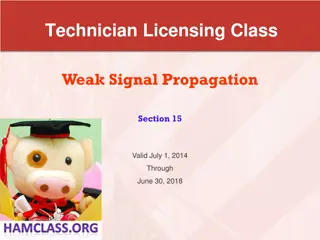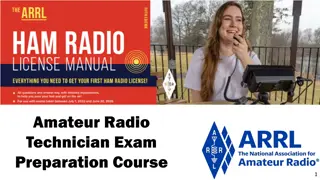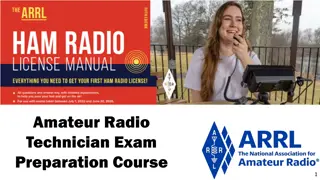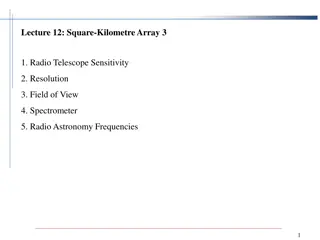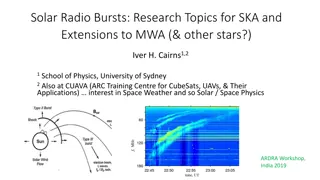The Impact of Ham Radio in Space Exploration
Ham radio has played a crucial role in space exploration, from its first use by Owen Garriott in 1983 to its integration into the International Space Station (ISS) through organizations like ARISS. This technology has enabled communication between astronauts and amateur radio operators on Earth, fostering educational opportunities and connections. The legacy of ham radio in space continues to inspire and engage enthusiasts worldwide.
Download Presentation

Please find below an Image/Link to download the presentation.
The content on the website is provided AS IS for your information and personal use only. It may not be sold, licensed, or shared on other websites without obtaining consent from the author.If you encounter any issues during the download, it is possible that the publisher has removed the file from their server.
You are allowed to download the files provided on this website for personal or commercial use, subject to the condition that they are used lawfully. All files are the property of their respective owners.
The content on the website is provided AS IS for your information and personal use only. It may not be sold, licensed, or shared on other websites without obtaining consent from the author.
E N D
Presentation Transcript
Ham Radio is Beneficial in Space Ham radio, first put into outer space by W5LFL in 1983, has now become a fun, educational tool for teachers and hams alike to use. It has become so useful in outer space that ARISS was founded in 1996 to put amateur radios on the ISS, and it has become a magnificent success.
The 1stHam Radio in Space Owen Garriott, W5LFL was the first person to carry a ham radio into space. He tried to get a ham radio on the earlier Skylab mission, but NASA rejected it because it was too late in the development of the program. With the help of ARRL (the American Radio Relay League) and AMSAT (the Amateur Radio Satellite Corporation), ham radio was finally allowed in STS-9 in 1983. W5LFL was allowed to bring 2 HTs, one as a spare. W5LFL was limited to 1hr/day on the air he could not interfere with mission activities.
Ham Radio on the ISS This is a photo of the initial radio station amateur equipment while it was being tested. After testing, the equipment was stowed aboard space shuttle Atlantis for delivery to the international space station during STS- 106. http://spaceflight1.nasa.gov/station/reference/radio/
W5KWQ, the Son of W5LFL Richard Garriott, son of Owen Garriott, was aboard the ISS in October 2008 and made many QSOs with amateur radio operators and schoolchildren. Because amateur radio operators favorite QSL cards are those from outer space, all hams that got a contact (too bad most of us weren t hams then!) are extremely grateful he decided to go on the air. He s giving a talk on May 15 at the AMSAT/ TAPR Banquet during Hamvention 2009 in Dayton, Ohio.
The Formation of ARISS ARISS (Amateur Radio on the International Space Station) was founded in 1996 when delegates from major radio corporations, including AMSAT, signed a Memorandum of Understanding to form ARISS. Their Memorandum also formed the ISS Ham team. It helps eliminate all of the technicalities of the ham radios aboard the ISS.
ARISS-Ham Radio on the ISS Through ARISS (Amateur Radio on the ISS), hams from around the country can listen (and sometimes even talk) to the astronauts aboard the ISS. Of course, astronauts cannot spend all of their time talking on the radio unless they happen to be tourists! A tourist, Charles Simonyi, is going to the ISS relatively soon in May 27, even though he already went in March 26 (he s a billionaire).
ARISS and Education Through ARISS, schools can contact the ISS. When they do, the students can learn what life in space is like via questions. This will boost their interest in science, and we need more scientists. It will also get more people to want to be a ham which we also want!
The ISS Next time you hear news about the ISS being up tonight, try to contact it (if the astronauts aren t busy!) But hurry it s only up for 4 minutes. Backdropped against the Caspian Sea, this full view of the international space station was photographed by a crewmember onboard the Space Shuttle Discovery after the undocking of the two spacecraft. Image credit: NASA http://www.nasa.gov/mission_pages/statio n/main/s114e7221_feature.html
Space Suit with Transmitter Tune to 145.990MHz (the mode is FM ) Space suit w/ ham radio transmitter. Thrown into orbit 4/7/2009 by the ISS. Packed w/ transmitter+ 3 batteries Will burn up in Earth s atmosphere Packed with old clothes to look like a real person. It relays a secret message.
Its Good for Both Sides Ham radio can make astronauts feel more at home when they re on the ISS. Ham radio is fun, which might outweigh the feeling of homesickness. Hams on the ground jump at the chance to receive a CQ from outer space. Lots of hams are probably tuning 145.990 there s a space suit on that frequency. So listen to that spacesuit and contact the ISS.
Citations AMSAT. AMSAT-Dayton Hamvention 2009. 6 March 2009. 12 April 2009 <http://www.amsat.org/amsat-new/hamvention/2009/Dayton.php>. ARRL. ARRL Web: Ham Radio Lets ISS Crew Members Connect with Schools Around the World. 18 April 2007. 9 April 2009 <http://www.arrl.org/news/stories/2007/04/18/101/>. Clarke, Emily. AMSAT-the Amateur Radio Satellite Corporation. 30 March 2009. 9 April 2009 <http://www.amsat.org/amsat-new/index.php>. Harwood, William. "Tourist and 2 Others on Way to Space Station." The New York Times 26 March 2009 NASA. "STS-9 and Amateur Radio." NASA Educational Briefs (1983): 3-5. NASA. Ham Radios in Space. 21 August 2000. 9 April 2009 <http://science.nasa.gov/headlines/y2000/ast21aug_1.htm>. NASA. International Space Station Reference. 9 April 2009 <http://spaceflight1.nasa.gov/station/reference/radio/>. NASA. STS-144e7221. 9 April 2009 <http://www.nasa.gov/images/content/136653main_s114e7221_high.jpg>.
